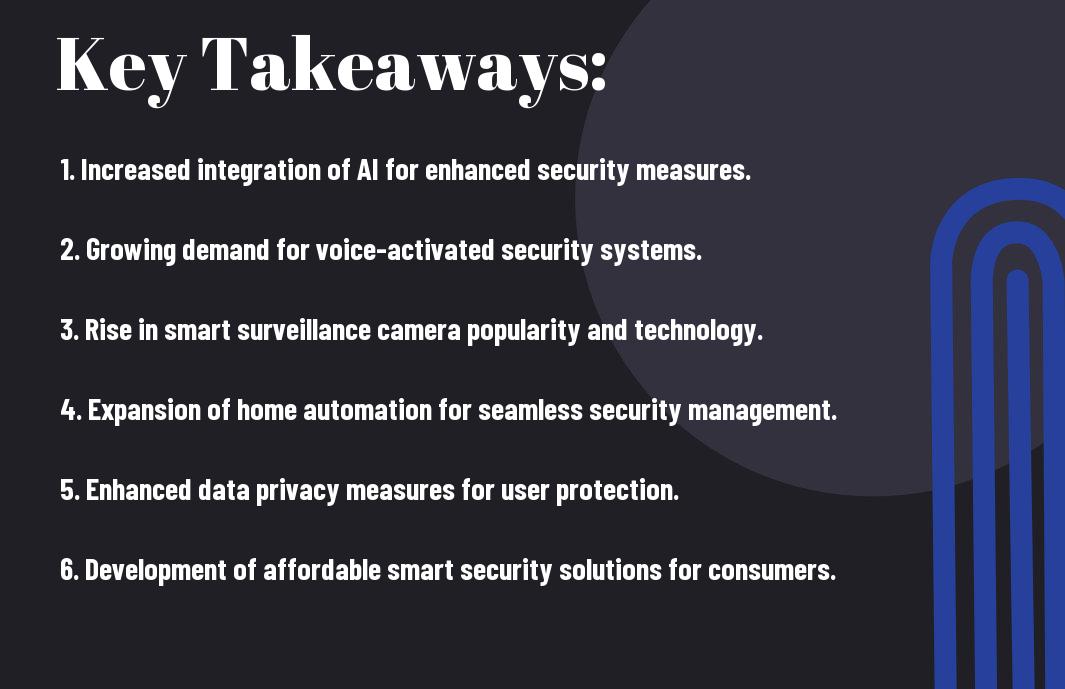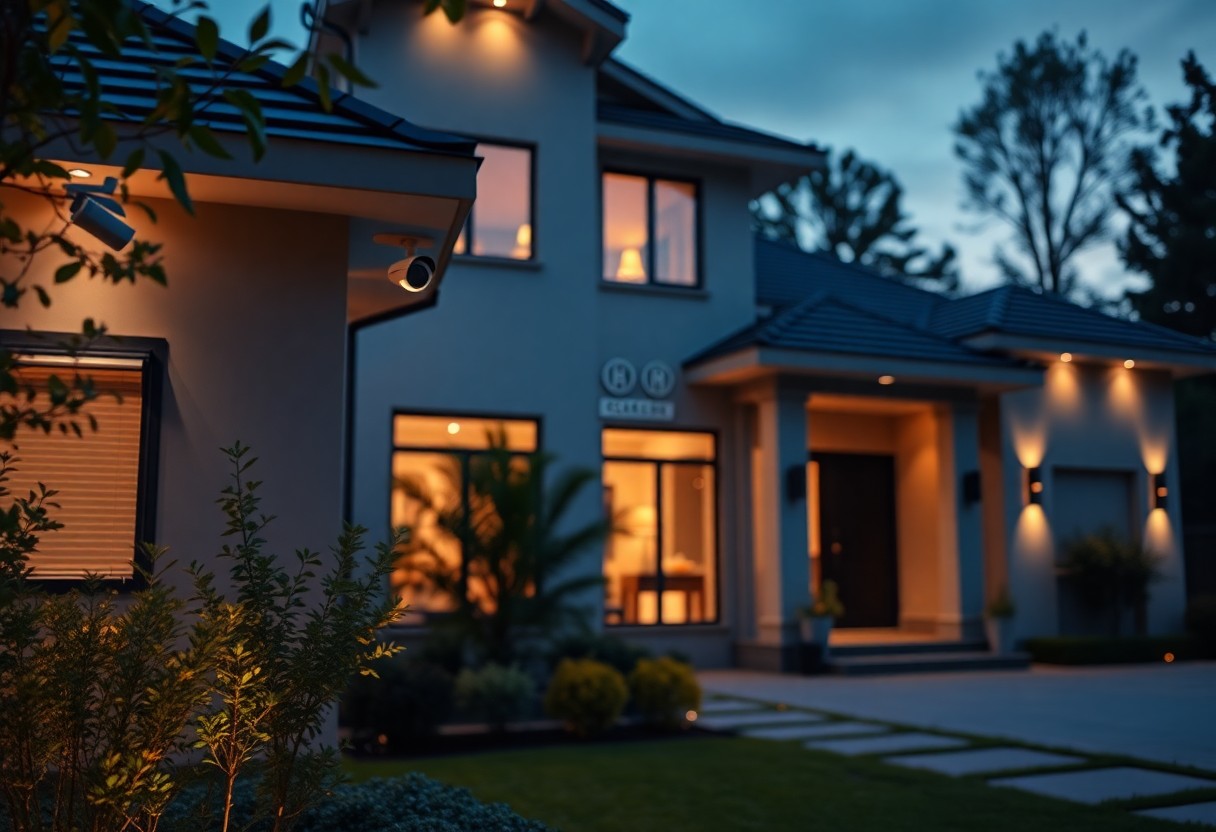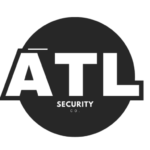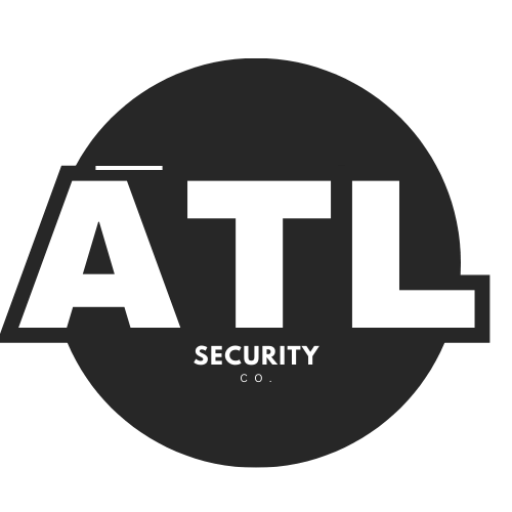It’s crucial for you to stay informed about the ever-evolving landscape of smart home security. As technology continues to advance, innovative solutions are reshaping how you protect your home and loved ones. From integrated AI systems to enhanced home automation features, this blog post will research into the key trends that you should watch for in the coming years. By understanding these developments, you can make informed decisions that enhance your home security and ensure peace of mind.
Key Takeaways:
- Integration of AI and machine learning will enhance threat detection and response capabilities, making security systems smarter and more responsive over time.
- Smart home security devices will increasingly focus on user privacy and data protection, leading to more transparent data handling practices.
- The rise of interconnected IoT devices will promote the development of comprehensive security ecosystems that can communicate and protect against various threats.
- Adoption of biometric authentication methods, like facial recognition and fingerprint scanning, will provide stronger access controls for smart home systems.
- Subscription-based security monitoring services will gain popularity, offering users more flexibility and tailored options for their home security needs.


The Evolution of Smart Home Security
To understand the future of smart home security, it’s imperative to recognize how it has evolved over the years. From traditional locks and alarms to advanced smart systems, innovation has transformed the way you protect your home. The integration of technology has heightened security measures and made it easier for you to monitor and control your home environment from anywhere at any time.
Technological Advancements
Along the way, technological advancements have played a significant role in enhancing smart home security solutions. High-definition cameras, motion detection, and biometrics have become commonplace, allowing for greater surveillance and access control. These innovations not only improve your home security but also contribute to a more user-friendly experience.
Integration with IoT Devices
An important trend shaping smart home security is its integration with IoT devices. With interconnected systems, your home security can communicate seamlessly with other smart devices, enhancing overall protection.
Considering the benefits of integrating your security system with various IoT devices, you can enjoy a more cohesive home automation experience. Imagine receiving an alert on your smartphone when your doorbell camera detects motion, while your smart lights flash, deterring potential intruders. This interconnectedness allows you to manage your home more effectively, automating responses to security threats and providing peace of mind, regardless of where you are.
Key Trends Shaping the Future
There’s an exciting evolution in smart home security, driven by innovative technologies and shifting consumer expectations. As security solutions become more sophisticated, you can expect an increased emphasis on personalization and adaptability. From AI-driven systems to enhanced monitoring capabilities, these trends will redefine how you protect your home in the coming years.
Artificial Intelligence and Machine Learning
With advancements in artificial intelligence (AI) and machine learning, smart home security systems will become increasingly intuitive. These technologies enable your security devices to learn from your behavior and adjust settings to better meet your needs. This means faster response times and more accurate threat detection, allowing you to feel more at ease.
Enhanced Surveillance Systems
Shaping the landscape of home security, enhanced surveillance systems are integrating cutting-edge technologies like 4K resolution and smart analytics. These improvements provide you with clearer images and actionable insights, allowing for more effective monitoring. As a result, your ability to assess potential threats in real-time will be significantly improved.
Enhanced surveillance systems are not just about clearer video feeds; they incorporate advanced features such as facial recognition and motion detection. These capabilities can differentiate between familiar faces and strangers, providing you with tailored alerts. Furthermore, cloud storage allows for easy access to recorded footage, ensuring that you have the information you need at your fingertips if an incident occurs.
Privacy and Data Security Concerns
For anyone investing in smart home security, privacy and data security concerns are paramount. As your home becomes more connected, the vast amounts of data generated can create vulnerabilities. Understanding how your personal information is collected, stored, and shared is crucial for ensuring your security systems provide peace of mind rather than potential risks.
Protecting User Data
Protecting your data involves implementing robust security measures like encryption, secure authentication, and regular software updates. By choosing devices and systems that prioritize user privacy, you can help safeguard your personal information against unauthorized access and cyber threats. Additionally, being proactive in managing your privacy settings can significantly enhance your overall security.
Regulatory Developments
By staying informed about regulatory developments in the smart home security space, you can better understand the evolving requirements that impact your devices. This knowledge empowers you to make informed decisions when selecting systems that comply with privacy and security standards.
It is crucial to be aware of regulations such as GDPR in Europe and CCPA in California, which enforce strict guidelines on data usage and privacy. As these regulations continue to evolve, they will likely influence how manufacturers handle your data, ensuring that your privacy is prioritized. Keeping an eye on these developments will help you choose smart home technologies that align with your privacy expectations.
User Experience and Accessibility
After the rapid evolution of smart home technology, user experience and accessibility are vital factors influencing product design. As security systems become more integrated into daily life, ensuring they are intuitive and easily navigable will enhance your interaction with these devices. The goal is to make smart home security systems more user-centric, allowing you to manage them effortlessly, regardless of your technical knowledge or experience.
Simplified Interfaces
To boost engagement, manufacturers are focusing on creating simplified interfaces that make navigating smart home security seamless. By emphasizing minimalistic designs, you can quickly access crucial features and settings without feeling overwhelmed by unnecessary complexities. The easier it is for you to understand and use the system, the more effectively you can leverage its capabilities to protect your home.
Voice Control and Automation
On the forefront of smart home advancements, voice control and automation significantly enhance your experience, allowing you to manage your security system with simple voice commands. This hands-free interaction not only improves convenience but also allows you to multitask, making security management less intrusive in your daily life.
Considering that voice assistants have become commonplace in many households, integrating voice control into smart home security systems is a natural progression. You can easily arm or disarm your system, check security status, or receive alerts solely through spoken commands. This accessibility empowers you to control your home’s safety without needing to navigate apps or physical devices, thereby streamlining your experience and enhancing your peace of mind.
The Rise of Subscription-based Services
Many homeowners are turning to subscription-based services for smart home security, as they offer flexible options for monitoring and protection without the need for large upfront costs. These services can include 24/7 monitoring, cloud storage for video footage, and remote access to security features, enhancing your peace of mind. As technology advances, you can expect these offerings to become increasingly comprehensive, tailoring to your specific security needs.
Benefits and Drawbacks
Behind the convenience of subscription-based services lie both advantages and disadvantages. On one hand, you gain affordability and the ability to scale your security systems easily. On the other hand, ongoing fees may accumulate, and you could find yourself tied into long-term contracts. It’s crucial to weigh these aspects carefully to ensure the service aligns with your needs.
Future Market Predictions
Predictions for the smart home security market indicate a shift towards more personalized, user-centric subscription models. As technology continues to advance, the demand for integrated systems and customizable features is likely to rise. You can expect an increase in partnerships between security companies and tech innovators, leading to improved user experiences and even more tailored solutions that adapt to your specific lifestyle and security demands.
Future growth in the smart home security market will be driven by advancements in artificial intelligence and machine learning, enabling systems to better understand your habits and preferences. This evolution will result in intuitive solutions that identify potential threats proactively. As you consider subscribing to these services, look for companies that prioritize innovation and customer support, ensuring your home remains secure and insightful while fitting seamlessly into your lifestyle.
The Role of Smart Home Ecosystems
Once again, smart home ecosystems are redefining how you manage home security. These interconnected platforms allow devices to communicate seamlessly, providing a comprehensive security solution that integrates with your lifestyle. As smart home technology evolves, you’ll notice an increased emphasis on creating cohesive experiences that enhance your safety and convenience, offering centralized control and automation to meet your unique needs.
Compatibility and Interoperability
At the core of effective smart home ecosystems is compatibility and interoperability. You want your devices to work together harmoniously, allowing for streamlined operations without the hassle of managing disparate systems. The ability for your security cameras, alarms, and smart locks to communicate offers a more robust and responsive home security network, making your life easier and your home safer.
Leading Brands and Offerings
Beside compatibility, the market is filled with leading brands and offerings that enhance your home security experience. Companies like Nest, Ring, and Arlo are setting industry standards with innovative products that integrate seamlessly into your smart home. These brands not only prioritize security but also focus on usability, allowing you to maximize convenience without compromising safety.
To help you make informed decisions, it’s important to stay updated on the latest offerings from top brands in the smart home security space. Each brand comes with its unique features and benefits, such as high-resolution video, advanced motion detection, and user-friendly interfaces. Understanding these options can empower you to create a customized security solution that fits your home and lifestyle while ensuring you feel protected and in control.
To wrap up
Drawing together the insights from emerging technologies and trends, the future of smart home security promises to enhance your protection and peace of mind. As you explore options like AI-driven systems, integrated devices, and advanced monitoring capabilities, you will find opportunities to customize security to your home’s specific needs. Staying informed about these advancements will empower you to make strategic decisions, ensuring that your home remains safe and secure in an increasingly connected world.
Q: What are some emerging technologies that will influence smart home security systems in the coming years?
A: In the future, smart home security is expected to be greatly influenced by advancements in artificial intelligence (AI) and machine learning. These technologies will enable systems to analyze patterns of behavior and adapt to the homeowner’s routines, enhancing security alerts and responses. Additionally, the integration of IoT devices will allow for improved communication between various security components, such as cameras, smart locks, and alarms, creating a more cohesive and responsive security network. Biometric security measures, like facial recognition and fingerprint scanning, are also likely to become more commonplace, offering higher-level security options.
Q: How will privacy concerns shape the development of smart home security solutions?
A: As smart home security systems become more interconnected, privacy concerns will significantly influence their design and implementation. Users are increasingly aware of the data being collected by these systems, which may include personal habits, location data, and video footage. In response, companies will likely prioritize transparency in their data handling practices and offer users greater control over their information. Technologies such as edge computing, where data is processed locally on devices rather than in the cloud, may become more prevalent as a way to enhance privacy while still providing effective security solutions.
Q: What role will user-friendly interfaces play in the evolution of smart home security systems?
A: User-friendly interfaces will be vital in driving the adoption of smart home security systems among a broader audience. As technology continues to advance, manufacturers will focus on developing intuitive applications and control panels that simplify the setup and management of security systems. Features like voice control integration, customizable alerts, and easy-to-navigate companion apps will make it easier for users, regardless of their technical expertise, to monitor and manage their home security. This emphasis on usability is expected to lead to greater customer satisfaction and retention in the smart home security market.


